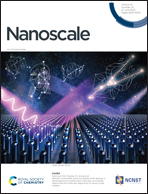Mode-dependent energy exchange between near- and far-field through silicon-supported single silver nanorods†
Abstract
Optical antenna effects endow plasmonic nanoparticles with the capability to enhance and control various types of light–matter interaction. Most reported plasmonic systems can be regarded as single-channel nanoantennas, which rely only on a bright dipole plasmon mode for energy exchange between near- and far-field. Herein we demonstrate a dual-channel plasmonic system that can separate the excitation and emission processes into two energy exchange pathways mediated by the different plasmon modes, offering a higher degree of freedom for the manipulation of light–matter interaction. Our system, consisting of high-aspect-ratio Ag nanorods and Si substrates, can support a series of bright and dark plasmon modes with distinct near- and far-field properties and generate relatively intensive local field enhancement in the gap region. As a proof-of-principle, we take plasmon-enhanced fluorescence of dye molecules as an example to reveal the energy exchange mechanism in the dual-channel plasmonic system. Such a system is potentially also useful for manipulating other types of light–matter interaction. Our work represents a step toward the utilization of a broader class of plasmon resonance for the development of optical antennas and various on-chip nanophotonic components.



 Please wait while we load your content...
Please wait while we load your content...